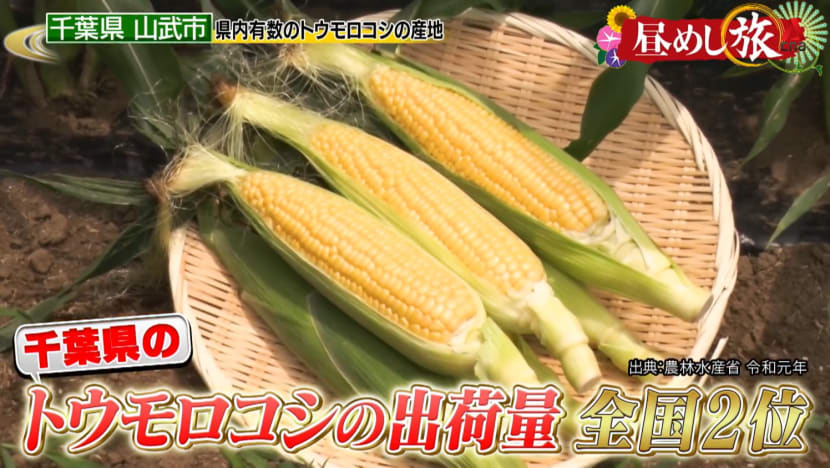It's Lunch Time - Saitama Prefecture part 2
This week's food investigation highlights a farm specialising in leeks, an award-winning taro sauce and a huge camping ground where guests can also experience harvesting vegetables all year round.

This week, we visit more cities to find out what the locals eat. Our first destination is Sayama in Saitama Prefecture. The city's speciality is Sayama tea. We visit a local family who has been farming for more than 300 years. At Ochiai Farm, 60 tonnes of leeks are produced a year by Toshio Ochiai and his son Masashi. They harvest about 4,000 leeks every day and even edamame. The family also has a greenhouse which Mr Toshio looks after. Here, tomatoes, cucumbers and asparagus are grown. The family eats the vegetables they harvest and even sells them at an unmanned store in front of the farm.
We want to see what the Ochiai family usually eats so we go to their house next to the leek farm. The two-family house was built about 10 years ago. We meet Mr Masashi’s mother, Ms Fusako. For lunch, she makes homemade roasted pork with leeks, homegrown asparagus wrapped in pork and rice mixed with edamame. We ask the family if they know anybody who can show us their meal. We are told about their family friend, Mr Iwata, who runs an Italian restaurant near Shin-Sayama Station. Rucosso opened about four years ago and its most popular dish is the tomato cream pasta with blue crab and snow crab meat. One of its recommended desserts is Sayama matcha tiramisu, using matcha and tea from Miyanoen, a famous shop in Sayama.
Mr Iwata agrees to show us the meal he is preparing for his employees. It includes a green salad with homemade carrot dressing and his speciality, fresh pasta with smoked duck and leeks. The pasta is served with a special sauce made from taro. Saitama Prefecture is the top producer of taro in Japan, with Sayama being one of the leading producers of taro in the prefecture. To promote Sayama’s taro, a cooking competition featuring taro dishes was started three years ago. Mr Iwata’s original taro sauce won the grand prize at the event.
Next, we investigate what people eat in Sanmu City, Chiba Prefecture. The prefecture is one of Japan’s top producers of corn. So we first visit corn farmer Tsuyoshi Watanabe. Each year, he harvests 10,000 cobs of a type of sweet white corn called Roishi. He sells this corn to local stores, roadside stations and restaurants in Tokyo. The family grows about 200 kinds of vegetables on their farm, including green peppers and zucchini.
Mr Tsuyoshi agrees to show us his meal. He is going to have lunch at a farmhouse restaurant run by his sister, Yoko. The family’s meal includes salad, corn soup and an oven-baked pizza. The salad is served with a dressing made with grated steamed beets, onions and carrots seasoned with rice vinegar. The corn soup prepared by their mother is seasoned with salt, pepper, consomme and fresh cream. The pizza includes Roishi corn, homegrown onions, green peppers, aubergines, carrots and bacon. It is baked in a hand-built pizza oven by their father. Other dishes are grilled pork belly marinated in special miso mixed with herbs and simmered black beans.
The next stop of our food investigation in Sanmu City is the Arinomien Auto Camping Ground. We meet Shoji Suzuki, who has been running the campground for nearly 30 years. There are 85 campsite plots in total; each plot is big enough to park a car and put up a tent. We take a tour around the campground. It has a large outdoor pool, coin-operated showers, toilets, washing machines and dryers. There are also fields where campground guests can experience harvesting vegetables. About 40 different kinds of vegetables are grown here and the harvested vegetables are used for camp meals. Mr Shoji used to run a pear farm and now grows seasonal vegetables and fruits.
We request to see Mr Shoji’s dinner. We meet his wife, who first makes barbecued plank salmon. The salmon is marinated with a blend of 12 different spices, including soya sauce powder, after which Mrs Suzuki places it on a cedar plank which has been soaked in water for half a day. The plank is smoked, which gives a slightly smoky flavour to the food. She then puts a lid on and lets the salmon cook for 20 minutes.
After this, Mrs Suzuki prepares clam risotto using small clams from Kujukuri Beach called Zenna. After stir-frying onions, green beans, bell peppers and other vegetables with the soup stock of clam, she adds cooked rice and tops it with grated cheese. She also wraps freshly harvested potatoes in aluminium foil and cooks them for 30 minutes in a bonfire and later serves them with butter. Other dishes prepared include cold tofu served with leek sauce made with chopped perilla and noodle sauce, as well as salted rice malt soup with summer vegetables.
Tips:
1) A must-try item of Saitama Prefecture is taro
2) Chiba Prefecture’s Sanmu City is famous for its corn












